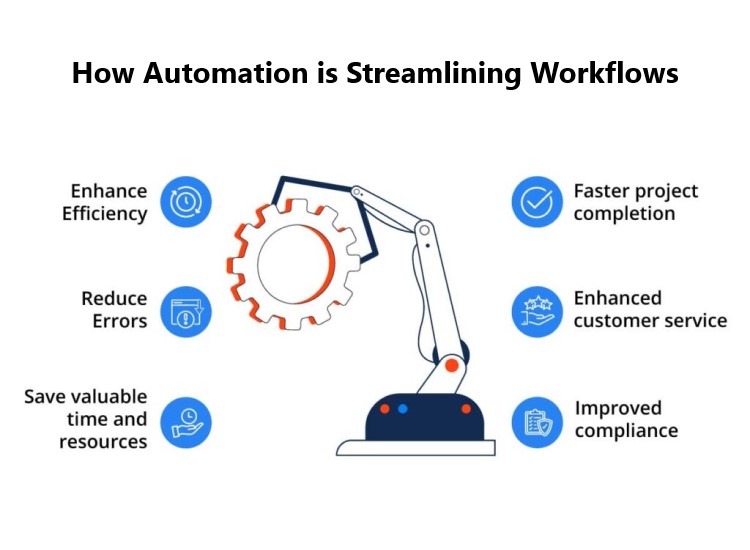
Introduction to Workflow Automation
Workflow automation involves using technology to streamline and automate repetitive tasks within business processes. It helps you reduce manual effort by automating tasks that would otherwise take time and resources. By using automation, businesses can improve efficiency, minimize errors, and ensure tasks are completed consistently. This makes automation a key component in modern business operations.
As more companies adopt digital tools, the importance of automation continues to grow. From customer service to inventory management, businesses are discovering how automation is streamlining workflows across various departments. By automating routine processes, you free up time for your team to focus on higher-value tasks, leading to greater productivity and innovation.
Additionally, workflow automation provides real-time data and insights, allowing you to monitor performance and make adjustments quickly. As businesses increasingly rely on data-driven decisions, the role of automation in optimizing operations will only expand. Understanding how automation is streamlining workflows will be essential for staying competitive in today’s fast-paced business environment.
Improving Efficiency with Automated Processes
Automated processes are transforming the way businesses operate by improving efficiency and productivity. By reducing manual tasks, automation helps you streamline repetitive activities that would otherwise take up significant time. From data entry to scheduling, automation enables your team to focus on more strategic tasks, boosting overall performance.
One of the key benefits of automation is the speed at which processes are completed. Automated systems work faster than manual efforts, allowing you to accelerate workflows and meet deadlines more easily. As a result, businesses can handle larger volumes of work without increasing labor costs. This is a clear example of how automation is streamlining workflows and driving greater output.
In addition to saving time, automation also ensures consistency and reduces errors. Automated processes follow predefined rules, minimizing the risk of human mistakes that could delay projects. By improving accuracy and speeding up operations, automation helps you deliver higher-quality results while maximizing efficiency. Ultimately, understanding how automation is streamlining workflows is critical for any business looking to stay competitive.
Reducing Human Error and Enhancing Accuracy
Automation plays a key role in reducing human error and enhancing accuracy in business operations. By automating repetitive tasks, you can minimize mistakes that often result from manual processes. This improves consistency in daily workflows, ensuring that each task is completed correctly every time. As automation follows pre-set rules, it eliminates the variability that can occur when tasks are performed by different individuals.
One of the major benefits of automation is that it helps maintain high levels of accuracy, especially when dealing with complex data or large volumes of work. When businesses rely on manual input, errors can easily occur due to fatigue or oversight. Automation mitigates these risks, providing error-free results. This is another example of how automation is streamlining workflows and helping businesses maintain precision.
Moreover, automating tasks also improves reliability. You can trust that automated systems will follow procedures consistently, without the inconsistencies that come from human involvement. By reducing human error and enhancing accuracy, automation not only boosts productivity but also builds trust in your processes. This makes it a valuable tool for businesses focused on efficiency and quality.
Cost Savings Through Automation
Automation offers significant cost savings by reducing the need for manual labor in repetitive tasks. When you automate routine processes, you free up employees to focus on more valuable work. This not only improves productivity but also helps you optimize resource allocation, ensuring that you make the most of your workforce. By streamlining tasks, automation reduces the time and effort required to complete them, leading to lower operational costs.
Another way automation saves costs is by minimizing errors that can lead to rework or delays. Mistakes in manual tasks often require additional time and resources to fix. Automating these processes increases accuracy, helping you avoid costly mistakes. This is a clear example of how automation is streamlining workflows and directly impacting the bottom line.
Additionally, automation tools can help you scale operations without significantly increasing overhead. By automating certain functions, your business can handle more volume without needing to hire additional staff. This scalability allows you to grow efficiently while keeping expenses under control. As a result, automation becomes a powerful tool for managing costs and driving profitability.
Automation Tools for Different Business Functions
Automation tools are transforming different business functions, helping you streamline workflows across departments. In marketing, tools like HubSpot and Mailchimp automate email campaigns, social media scheduling, and lead tracking. These tools not only save time but also provide insights into customer engagement, allowing you to refine strategies. This is one example of how automation is streamlining workflows and driving better results.
In finance, automation tools like QuickBooks and Xero simplify tasks such as invoicing, expense tracking, and payroll management. These systems reduce manual data entry and ensure financial accuracy, helping businesses stay on top of their finances. Automated financial reporting also provides real-time insights, enabling faster decision-making and improved cash flow management.
Customer service is another area where automation has a major impact. Tools like Zendesk and Freshdesk use AI-powered chatbots to handle routine inquiries, allowing your team to focus on more complex issues. These tools enhance customer experiences by providing instant responses and reducing wait times. As automation tools continue to evolve, businesses in all areas can streamline operations and focus on higher-level tasks that drive growth.
Future of Automation and Its Impact on the Workforce
The future of automation promises to reshape industries and the workforce. As technology advances, businesses are likely to see even more processes automated. From AI-driven analytics to robotics, automation will continue to reduce the need for manual labor in repetitive tasks. This shift highlights how automation is streamlining workflows, enabling businesses to operate more efficiently and focus on higher-level strategies.
However, as automation grows, its impact on the workforce cannot be ignored. While it may reduce demand for certain roles, automation also creates opportunities for new jobs. Roles related to managing, maintaining, and developing automated systems are on the rise. You can adapt by upskilling your workforce, ensuring they are prepared for this evolving landscape.
Businesses must also focus on a balance between technology and human capital. Automation handles routine tasks, but human expertise is still needed for creativity, problem-solving, and leadership. By blending automation with a well-trained workforce, your business can thrive in this changing environment. The future of automation will push companies to innovate, making workforce adaptability a key priority for continued success.
Conclusion
In conclusion, automation is transforming the way businesses operate by improving efficiency and reducing manual tasks. As technology advances, how automation is streamlining workflows will continue to evolve, offering more opportunities for growth and optimization. Businesses that embrace automation can save costs, minimize errors, and boost productivity. By adapting to these changes and upskilling your workforce, you position your business to thrive in a rapidly shifting landscape. Automation will remain a key tool in helping businesses succeed and stay competitive in the future.


